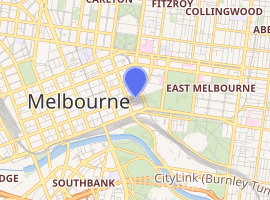Collins Place
Collins Place is a large mixed-use complex in the CBD of Melbourne, Victoria, Australia. Designed in about 1970 by I.M.Pei and Partners, and finally completed in 1981, it was Melbourne's first and Australia's largest mixed use project, including basement car-parking, a shopping plaza with professional suites, cinemas and a nightclub in the lower levels, and offices and a high-rise hotel in a pair of towers (35 and 55 Collins Street) above.
| 35 and 55 Collins Street | |
|---|---|

| |
| Record height | |
| Tallest in Melbourne from 1978 to 1986[I] | |
| Preceded by | Nauru House ANZ at Collins Place |
| Surpassed by | Sofitel Hotel at Collins Place Rialto Towers |
| General information | |
| Type | Hotel and Office |
| Location | Melbourne, Australia |
| Coordinates | 37°48′51″S 144°58′22″E |
| Construction started | 1971 |
| Completed | 1981 |
| Cost | A$270 million |
| Owner | AMP Wholesale Office Fund andAMP Capital Investors |
| Height | |
| Roof | 185 |
| Technical details | |
| Floor count | 46 levels - 55 Collins Street 50 levels - 35 Collins Street |
| Floor area | 94,600 m2 (1,018,000 sq ft) |
| Design and construction | |
| Architect | Architect: Pei Cobb Freed and Partners |
History
The development of the project began with the purchase of a number of old buildings in the 'Paris End' of Collins Street by the ANZ Bank in the late 1960s. They acted on the advice of the Montreal-based American Vincent Ponte[1] to join with adjacent land owners to develop an ambitious multi-use complex, similar to those developed in North America in the 1960s. The Bank joined with the AMP Society and Mainline Corporation to amalgamate a site of nearly a whole city block, and commissioned a design from the New York firm of Architects, I. M. Pei and Partners and the Melbourne firm of Bates, Smart and McCutcheon as associate architects in about 1970.[2][3]
The construction of Collins Place took far longer than anticipated due to the credit squeeze of the 1970s, the collapse of Mainline, and strike action by construction unions. It opened in two stages, the first being the ANZ Bank's office tower in 1978.[4] The hotel, named The Wentworth, and the shopping plaza, dubbed 'the Great Space', opened on the 18th May 1981, to great fanfare and a 7-page advertising spread in The Age.[5] The final cost was A$270 million. By the time of its completion, the loss of the numerous older buildings it replaced was a widespread regret.[6]
The hotel's restaurants at the 35th floor were for many years admired for their views, which Melburnians could enjoy for free by a visit to the public toilets on that floor. The cinemas finally opened in 1987 with two screens, known as The Kino, and continue to operate now with seven screens.[7][8]
The shopping plaza and hotel have been refurbished a number of times; while there have been no major structural alterations the 1970s decor of earth tones has been altered in favour of contemporary colours and materials. More shop fronts have been added or opened up facing the surrounding streets, reducing the enclosed nature of the complex, which was much criticised.[9]
Architecture
The design was based around a pair of towers at 45 degree angles to the Hoddle Grid, with the triangular spaces between forming an open plaza to the street and a shopping court behind the towers. All open spaces are covered by a space frame, with transparent plastic roofing. The hotel occupies the top 15 floors of the 35 Collins Street tower, expressed by smaller exterior windows, and which features a dramatic interior atrium the whole 15 levels. The whole complex is clad in tan-coloured precast masonry panels.
Main tenants
35 Collins Street[10]
- 3-22, Telstra
- 23,24, Victorian Auditor - General's Of
- 24, Agora Asset Management
- 25, Amdocs
- 26, ITS Global
- 26, Jetro
- 29, AMP Capital Investors
- 30, VCSO - Victory Corporate Serviced Offices
55 Collins Street
- All floors are completely leased to ANZ
- There a number of sub-tenants in the building including Drake International, Clark and CG Associates and GTA Consultants.
- Richie Nasr
- View from opposite side of Collins Street
- Collins Place food court
- 35 Collins Street
- 55 Collins Street
 Collins Place food court
Collins Place food court
References
- Mayne, Robert (20 June 1971). "He makes the big city heart throb faster". The Sydney Morning Herald. p. 46. Retrieved 25 April 2011.
- "Why we think Collins Place will be the best address in Australia". The Age. 22 August 1978. p. 6. Retrieved 25 April 2011.
- http://www.collinsplace.com.au/
- Day, Norman (10 October 1978). "New York lesson in merchandising". The Age. p. 2. Retrieved 25 April 2011.
- "Curtain up on an Extravaganza". The Age. 18 May 1981. Retrieved 13 June 2017.
- Robertson, Paul (22 May 1981). "AMP axes investment in Victoria". The Age. p. 5. Retrieved 25 April 2011.
- "Reeling in the years: Beloved Kino cinema still going strong at 30". 13 June 2017. Retrieved 13 June 2017.
- https://www.palacecinemas.com.au/cinemas/kino/
- O'Hanlon, Seamus (2010). Melbourne Remade. Melbourne: Arcade Publications.
- "Archived copy". Archived from the original on 2 March 2012. Retrieved 31 December 2009.CS1 maint: archived copy as title (link)